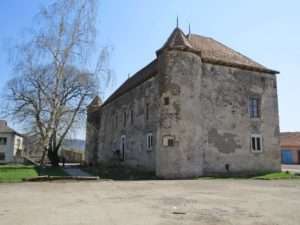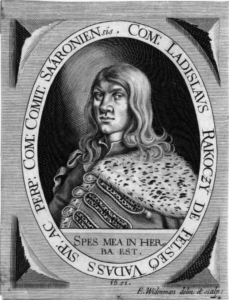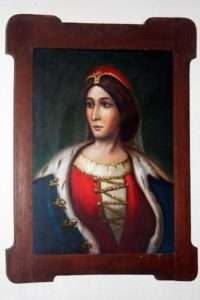Beregszentmiklós
Beregszentmiklós castle (Szentmiklós, Szolyvaszentmiklós, Ukrainian: Чинадійово [Csinagyijovo], Russian: Чинадиево [Csinagyijevo], Slovak: Činadno) is in the Latorca Valley, 10 km north-east of Munkács (Mukachevo), in the setlement of Beregszentmiklós. It is located in today’s Ukraine. It takes its name from the church dedicated to St. Miklós (Nicholas), whose worship spread from Byzantium to Hungary. The settlement was mainly a Hungarian royal estate in the Árpád era.

The castle was once an important fortification of the Huszt-Szentmiklós-Ungvár defensive line. It was naturally protected on the east side by the waters of the Latorca River, and on the other sides by earthworks and moats.
Description of the castle
The Telegdy-Rákóczi Castle is a U-shaped two-storey building. The building has round and polygonal corner towers protruding from the north and south corners. On the ground floor there is a cross-vaulted section with six rooms, a kitchen, and a large hall, once called the palace, while on the first floor, there are six small rooms and a large hall opening from a long narrow corridor.

Under the pent roof, there are loopholes all around, indicating the original purpose of the castle. Its walls are thick, its facades smooth, and most of its openings simple. Only the windows on the first floor of the corner towers are funnel-shaped and looped, while the two ground-floor windows on the southern façade are Renaissance. The latter are double windows with richly carved stone frames. Their upper corners have ornamental decorations, with sculpted eyebrow cornices above.

History of the castle:
In the 13th century, the village was in the hands of Bánk Bán’s son-in-law Simon. However, he lost it in 1214 because of Bánk’s assassination attempt on Queen Gertrude. Its name was first mentioned in 1236 as Saint Nicolai. Before 1263, King István (Stephen) the Younger of Hungary gave it to Mihály, son of Myco, the Comes of Bereg County, and as he also died without an heir, he gave it to Aladár, the queen’s treasurer, from whom the king took it back in 1264 in exchange for other property.

In 1270 it was given to the son of Endre Mihály of the Rosd clan and its boundaries were also written down. In this document, the name was written as Zenthmyklos. In 1309, the castle was again in the possession of Aladár’s relatives, when it became the property of Aladár’s son Chete, who gave it to his son János as his acquired property.

In 1331 it became a royal estate again. On May 10, 1387, King Zsigmond donated the Szentmiklós estate to Perényi Péter and his sons – Miklós, János, and Imre – together with the lands belonging to it. In 1403 King Zsigmond granted Perényi Imre the right to build a fortified castle in Szentmiklós. The castle was completed in the 1450s. The Perényi family owned the castle until 1542. Situated on the Galician trade route, Szentmiklós developed rapidly in the 15th century. It became a market town in 1456.

In 1572, King Maximilian I donated it to Count Frangepán Ferenc, who died shortly afterward, and it was returned to the treasury. In 1574, Telegdi Mihály received Szentmiklós as a pledge from Maximilian I for 22,000 forints. Telegdi Mihály had estates in Bihar and Csanád counties, but they were confiscated because he participated in a conspiracy against Prince Báthory István, and he settled here in Szentmiklós, where he spent the rest of his life. From 1610, the castle became the property of Telegdi Anna, then her husband Nyáry István, who rebuilt it in 1633. Nyáry was the owner of the castle until 1643.

In 1647, through Nyáry Krisztina, her husband Esterházy László became the owner. In 1649 it was given to Lónyay Zsigmond by King Ferdinand III. After Lónyay’s death, the estate and the castle were inherited by his widow, who was married to Rákóczi László, and thus the Munkács and Szentmiklós estates were inherited first by him and later by his successors, the Rákóczi family.

After the unsuccessful campaign of Prince Rákóczi II György in Poland, the Polish troops and the Crimean Tatar armies also destroyed the castle of Szentmiklós and its surroundings. The settlement of the Ruthenians, who were the loyal followers of Prince Rákóczi II Ferenc and suffered a lot of bloodshed during the War of Independence, increased.

In 1661 it was inhabited by Bánffi Erzsébet, the wife of Rákóczi László. In 1666 Rákóczi I Ferenc hid here after the failure of the Wesselényi Conspiracy, which ended in disaster. Then, the castle was in the hands of Eszterházy Mária, the widow of Homonnai Drugeth György. In 1669, King Leopold I agreed to allow the Rákóczi family to take over the Szentmiklós estate from the Esterházy family for 65,000 talers.

In 1673 it was mentioned as the property of Báthory Zsófia, the widow of Rákóczi Ferenc. After the death of Báthory Zsófia, the estate was taken over by Zrínyi Ilona for the benefit of her children, who often visited the estate to meet her future husband, Thököly Imre. You can read more about the history of the Subcarpathian region on my page:
https://www.hungarianottomanwars.com/maps/subcarpathia-karpatalja/
Prince Rákóczi Ferenc II often visited the late Renaissance castle of Szentmiklós during his hunting trips. On February 19, 1711, this castle was his last home in Hungary, where he spent the night before going to exile. Rákóczi considered the Ruthenians his most loyal nation. For decades after the end of the War of Independence, it was customary for Ruthenian families to put an extra plate on the table every day in case Rákóczi returned.

In 1711, after the peace treaty of Szatmár, Rákóczi’s property was confiscated by the Treasury, and in 1722 it was registered as the property of the Treasury. In 1726 King Charles VI gave Szentmiklós together with Munkács to Count Lothar Franz von Schönborn, Archbishop and Elector of Mainz. From then on it belonged to the Schönborn family. In 1728, the Schönborn family converted the castle into a beer house. In 1734, chimneys were added to the house. In 1734, the southwestern entrance of the castle was walled up by Jakab Marksteiner and moved to the opposite side of the castle. The castle was the subject of reconstruction in 1768 and again in 1839.

In 1910 Szentmiklós had 1646 inhabitants, mostly Ruthenians, with a significant German and Hungarian minority. Until the Treaty of Trianon, it belonged to the Szolyvai district of Bereg County. Until the year 2020, it included the settlements of Alsógereben (Alsóhrabonica), Beregvár, Pásztorlak, and Kékesfüred.

Before the Treaty of Trianon, 169 of the 1646 inhabitants of Szentmiklós were Hungarians and about 300 were Jews or Ishmaelites. The Hungarians were Roman Catholic, the Rusyns Greek Catholic. Their Greek Catholic church, which still stands today, was built in the early 14th century, of course as a Roman Catholic church at that time. In Soviet times the Orthodox religion was allowed, and now there is a return to Greek Catholicism and a serious dispute among the Orthodox over the use of the churches.

In 1943, when Subcarpathia briefly became part of Hungary again, the National Committee for Monuments carried out research and restoration work. At that time, two sgraffiti were found on the north and west walls, one of which showed the Rákóczi coat of arms in a triangular timpani.

Today, the castle is in a state of disrepair, having stood empty for a long time after the Soviet military withdrew. Bartos József, a painter, has rented it from the Ukrainian state as a studio and is trying to repair it bit by bit and raise funds for its renovation. The roof has already been replaced and some of the rooms can be used. He has also set up a small museum there. He likes to show the castle to passing tourists.

Photo: www.magyarorszag-szep.hu
Dear Readers, I can only make this content available through small donations or by selling my books or T-shirts:
Please, feel free to support me with a coffee here: You can check out my books "33 Castles, Battles, Legends" and "The Ring of Kékkő Castle" on Amazon or Draft2Digital, they are available in hardcover, paperback, or ebook: https://www.amazon.com/dp/198020490X or at https://books2read.com/b/boYd81
 My work can also be followed and supported on Patreon: Become a Patron!http://Become a Patron!
My work can also be followed and supported on Patreon: Become a Patron!http://Become a Patron!


https://hungarianottomanwars.myspreadshop.com/all






























